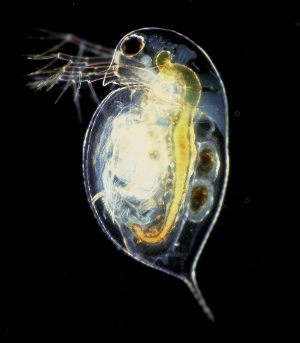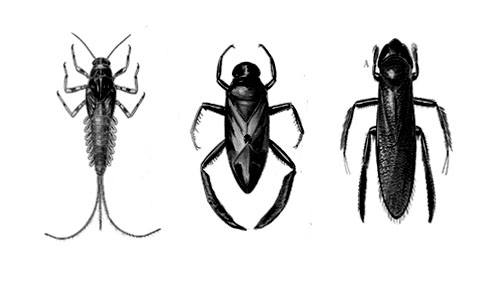UPCOMING EVENTS
View full calendarAquatic Ecology
HOME
Aquatic ecology is the study of the plants and animals that live in our rivers and streams and their interactions. These organisims are very sensitive to changes in water quality. Tolerant species (like leeches and carp) are those that thrive in polluted or altered ecosystems while intolerant species (like stoneflies and trout) are sensitive to small changes in water quality.
Phytoplankton and Zooplankton
 Phytoplankton are tiny plants that use sunlight and nutrients in lakes to grow. Polluted lakes
may host 'algae blooms' which can suck oxygen out of the water and may be toxic to
humans and animals.
Phytoplankton are tiny plants that use sunlight and nutrients in lakes to grow. Polluted lakes
may host 'algae blooms' which can suck oxygen out of the water and may be toxic to
humans and animals.

Zooplankton are small animals that drift and feed on small particles and organisims in the water column. Zooplankton are the favorite food of many types of fish and most juvenile fish.
Fish
 Fish, besides being a source of food and recreation for people, are important members of
aquatic ecosystems and indicators of water quality.
Fish, besides being a source of food and recreation for people, are important members of
aquatic ecosystems and indicators of water quality.
Fish occupy different niches in aquatic environments. In streams, fish like the native Bonneville Cutthroat Trout feed on macroinvertebrates while in lakes similar sized fish feed on both macroinvertebrates and zooplankton. Other types of fish are predators and help regulate the populations of invertebrates and smaller fishes via top-down control.
Not all species of fish can survive in a waterbody; temperature and water chemistry
determine which species of fish can inhabit a waterbody. For fish, two types of temperatures
limit growth and survival. They can survive exposure to warmer temperatures for short
periods (hours) but require cooler temperatures over longer periods of exposure. Time
of year and age of fish can also affect the temperatures that they require to grow.
Top Down Control

A healthy aquatic ecosystem contains a good balance of producers (like phytoplankton algae and leaves), consumers (like zooplankton and invertebrates) and predators like fishes.
The top consumer in an ecosystem excerpts top-down control on the populations of the consumers and producers.
In a lake, bluegill suppress the population of zooplankton via feeding. This then increases the population phytoplankton. This mechanism is known as top down control.
image from Historical Overfishing and the Recent collapse Jackson et al
Macroinvertebrates
 These animals, visible to the human eye and lacking a backbone, include many types
of insects as well as other animals such as worms, mollusks, and crustaceans.
These animals, visible to the human eye and lacking a backbone, include many types
of insects as well as other animals such as worms, mollusks, and crustaceans.
Macroinvertebrates often feed on plants, algae and things that fall into the stream / lake. In lakes they usually live in the shallow-water area around the edge of the pond amongst aquatic plants.
Macroinvertebrates are often used as indicator species to determine the health of water. Some species are more sensitive to pollution than others. In the pond, dragonflies and mayflies are indicative of a healthy aquatic community.
Click here to learn more about macroinvertebrates

 Macroinvertebrates
Macroinvertebrates